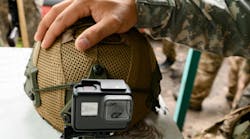The speed of both the development and dissemination of advanced technology is a cyclic, wavelike process, with major surges of disruptive development pushing the boundaries of what can be done on a constant basis. It is not unusual to meet someone on the street with a phone or computer several development generations ahead of, or behind, yours. This can lead to device situations akin to the time-dilation-related asymmetrical encounters in Joe Haldeman’s Forever War. This asymmetry of device technology can also be found on the battlefield.
Such technological asymmetry drives development on all sides, as players strive to either match existing technology, or push the design envelope further to maintain their lead on the battlefield. This also means that the best-equipped players on the battlefield represent the state of the art in technology at every level, from the combat drones they control in the air to the social-media GoPro cameras on their helmets. The external forces focused on a war from the surrounding warfighting and observational ecosystem is also a major factor.
One could call this the time of open-source warfare, too, especially in the information arena, open to anyone with the ability to participate. Armchair pundits buy access to data vendors and use that information to analyze and pontificate on the conflict, while many of the soldiers in the field wear cameras and run their own social-media channels.
The ability to monitor combat radio traffic, analyze the various signals-intelligence sources, and create actionable intelligence once required a Top Secret Cat III clearance at minimum. Today, you can listen to soldiers on the battlefield talking to their wives about the combat situation on YouTube.
Military Tech Online and in the Field
This social-media buzz and information transparency impacts every aspect of warfare today. Its influence has tentacles reaching into every facet of society and the marketplace. This can range from the mindset of existing and potential ally countries debating on aid and military support, to the morale and integration of the troops in the field. It is also now easier to verify claims of battlefield advances—there are websites where you can see a map showing the dynamic control of the terrain in detail.
Once upon a time, combat technology asymmetry meant that one side had a significant device and process advantage over the other, with full command of the land, sea, and air. Today, that asymmetry means that these devices and technologies could be found anywhere on the battlefield in anyone’s hands.
Depending on the situation and location, you could meet a squad of troops with steel helmets and WWII-era rifles; a team of soldiers with composite armor, advanced carbines, and night-vision systems; or a group of kids in street clothes with a bunch of hand grenades tied to toy drones. Or a guy in sandals with a laser designator for over-the-horizon attack weaponry.
When it comes to combat lethality, asymmetry in technological ability is deadly to the disadvantaged side. During the Cold War, European battle managers worked from a doctrine that essentially recognized that anything that can be seen can be hit, and anything that can be hit can be destroyed. This paradigm can be seen in deadly reality today.
Technical asymmetry also puts extremely powerful weapons into the hands of anyone with connections and/or money. Or ingenuity. Soldiers with limited means can leverage existing consumer technology that rivals multimillion-dollar weapons systems.
We should be cognizant of the new technical reality on the battlefield, where any and all weapons types and techniques could be encountered on any side. Such engagements will favor those who can best integrate the disparate solutions into a coherent battlefield strategy that leverages the strengths of each against the other.
Force multiplication via technology advances is a common thing today. The key is to understand and integrate the myriad technologies and tools into a unified effort that takes advantage of the opportunities of the situation at hand.
